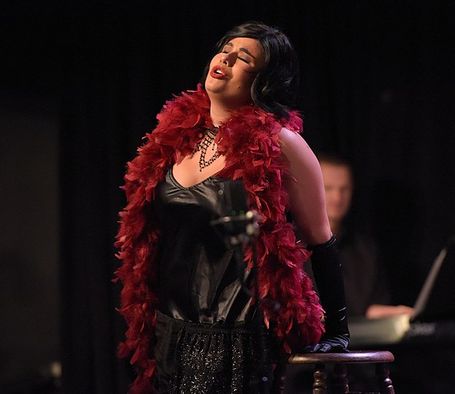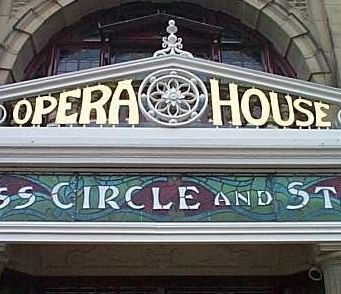
Where do I start?
If you were brought up on opera this section is not for you. But those of us who came to opera from a love of other music may find this helpful to get up to speed and enjoy more, more quickly.
Opera is musical theatre so you need to listen to some of the music and singing or better still watch a performance, that way you see the combination of drama, music and singing that is opera. Like many interests opera has its own terminology and jargon. Scroll down for your "Bluffer's guide" to some of the terms.
You may have heard of or seen something of a production but if not you might choose one of these three operas and watch some or all of it on YouTube. Of course these are personal choices and other people would choose something different to start with but you have to start somewhere. Or maybe ask a friend who is interested in opera to recommend something.
Mozart: The Magic Flute( German Die Zauberflöte:) wonderful music, fantasy plot, great fun but with some dark undertones
Verdi: Rigoletto from Dresden Opera, featuring global Peruvian “rock star” Juan Diego Flórez as the Duke of Mantua. Flórez started out singing in a rock band but moved on to opera. The Duke is the villain but gets some of the best tunes.
Rossini : Barber of Seville: begins with one of the best known arias in opera
Going on from here you might seek out the music or possibly performances on YouTube from the following list. (Any such list is personal and any other opera lover would probably produce a different one.)
Rossini
La Cenerentula
Mozart
Cosi fan Tutte
Don Giovanni
Donizetti
La fille du regiment
Lucia di Lammermoor
Verdi
Nabucco
La Traviata
Aida
Puccini
La Bohѐme
Tosca
Madama Butterfly
Wagner
Der fliegende Holländer (Flying Dutchman)
Tannhäuser
Some Sources of information
- Wikipedia entries for operas, singers, definitions of terms etc.
- Opera company web sites.
-The Metropolitan Opera of New York (“The Met” has a very comprehensive web site.
Metopera.org
From Menu select Discover for videos, articles etc.
- Special radio, TV, streams, podcasts etc.
BBC Radio 3 “Opera on Three” on the BBC website is an example
- Printed material - books, magazines, newspapers - including the two most quoted Opera Guides:
The New Kobbe's Opera Book – 4 Dec. 1997
by Earl of Harewood (Editor), Anthony Peattie (Editor)
(A bit expensive but close to the ultimate guide)
New Penguin Opera Guide – 1 Aug. 2002
by Amanda Holden (Editor)
- Opera Company Programme Books.
A bit more background
The heart of opera is the fusion of music, drama and spectacle. After opera developed around 1600 in Italy it moved rapidly from entertainment for the aristocracy to culture in the public space.
This has been less so in this country compared to Continental Europe so opera has often been seen as difficult or unapproachable. Today it has never been easier to get into opera. The language problem has been almost eliminated by surtitles or side screen in live performance and subtitles in the various electronic viewing media. There are multiple ways that opera can be experienced at low cost and the repertoire is vast and constantly growing both with new works and the discovery of neglected gems from the past. Handel operas for example, were a specialist interest only 30 years ago but now are mainstream for opera companies world wide and play to rave reviews.( Some might say that Handel is less accessible than Mozart for example, even opera lovers tastes vary)

Bluffer's guide
Some informal definitions of a few terms that it is useful to know.
Aria: a set piece song for a single singer or possibly a duet, accompanied by the orchestra.
Bel canto; Italian "Beautiful song or singing", Used as a general term to describe early 19th century operas from which come most of the stereotypes of opera in popular culture.
Coloratura: elaborate ornamentation of melody, often by a soprano but a tenor also.
Da capo aria. One for the posers this. A standard 3 part aria in the 18th century. The first part was repeated in the third with lots of flourishes enabling a soprano to flash her coloratora.
Gesamtkunstwerk: German "Complete/total work of art”. Coined by Wagner.
Grand opera: usually an opera on a serious theme which is entirely sung
Leitmotif ( also leitmotive): from the German meaning leading theme or motive. In opera it is most associated with Wagner who introduced recurrent musical themes associated with particular characters or situations.
Opera Buffa: a comic opera. Cf Opera seria
Opera seria: a serious opera most often used to refer to 18th century Italian works on serious themes, typically with a classical plot. Cf Opera Buffa
Operetta (also Light Opera or Comic Opera)
A form of music theatre, popular in the 19th and early 20th centuries, simpler and lighter in structure and form than “grand” opera and often comic or satirical. Many opera companies will include an operetta in their repertoire. (The Musical or Music Theatre is more or less the current equivalent).
Popular Examples of operetta are
- Offenbach “Orpheus in the Underworld” (1858/1874) with the Can-Can
- Lehar- “The Merry Widow” (1905)
- Johann Strauss II - “Die Fledermaus” (1874)
- Gilbert and Sullivan - “The Mikado” (1885)
- Britten - “Paul Bunyan” (1941/1976) - US folk legend
- Bernstein - “Candide” (1956/74) - after Voltaire
Park and bark: the traditional, now often regarded as old-fashioned, method of presenting an Aria. The implication is that the drama stops while the Aria is sung like a set piece.
Patter Song
A song or aria (or part of) with rapid delivery, close to speech.
Patter songs are often comic in content. Examples are
- “Largo al factotum” from Rossini - “The Barber of Seville”
- The Major General's Song from Gilbert & Sullivan - “The Pirates of Penzance”.
Prima Donna: Italian, referring to the leading lady in an opera company. Some such ladies gained a reputation for being difficult and demanding.
“The Ring “(The Ring Cycle - “The Ring of the Nibelung”
Four linked operas ( “Music Dramas”) by Richard Wagner, telling the story of the downfall of the ancient Northern gods. (Written and composed between 1848 and 1874)
- The Rhinegold
- The Valkyrie (“The Ride of the Valkyries” in Act 3)
- Siegfried
- The Twilight of the Gods” - Gotterdammerung
Recitative: sung speech
Singspiel: a typically German light opera combining spoken dialogue and singing. 20th century musicals like Guys and Dolls might be described as Singspiels. Mozart's The Magic Flute is the best known.
Trouser role: also described as breeches role. A male character in an opera played by and sung by a woman. Cherubino in Mozart’s The Marriage of Figaro is the best known. Such parts are often sung by a woman with a contralto voice.
Verismo: realism in an opera plot set in a realistic modern or recent real context. Puccini’s La Bohѐme would be a good example.
Voice types (high to low)
Women: Soprano, Mezzo-(soprano), Contralto
Men: Counter tenor, Tenor, Baritone, Bass
UNDER CONSTRUCTION
All rights reserved. Cheltenham Opera Society
© 2021
We need your consent to load the translations
We use a third-party service to translate the website content that may collect data about your activity. Please review the details and accept the service to view the translations.